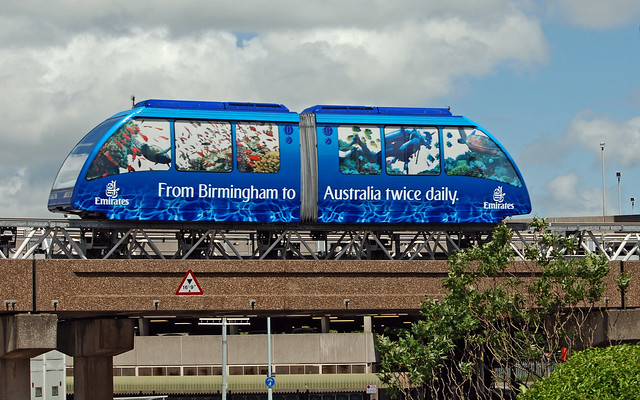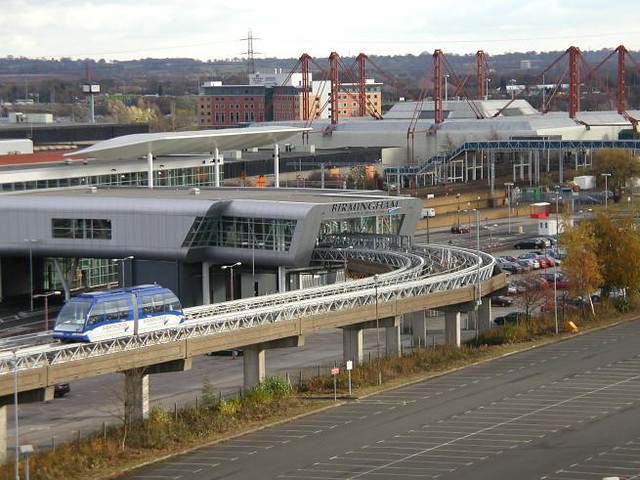This is a guest post by Ross Edgar.
The AirRail Link at Birmingham International Airport in the United Kingdom is a modern Cable Liner system. This is one of the lesser-known CPT lines. In fact to the untrained eye the AirRail Link simply looks like a high-level railway. However, on closer inspection the cars are driverless and are without motive power of their own. Instead, propulsion takes the form of a cable which lies between the two railway tracks, just as on a funicular line.
The AirRail Link opened on 7 March 2003 after two years of construction. It is 585m, or 1,921 feet, in length and connects Birmingham International Airport with Birmingham International Railway Station and the National Exhibition Centre (NEC), with a journey time of 90 seconds. The purpose of the AirRail Link is to connect the airport to the mainline railway station, from which a number of destinations can be reached at high speed.
The AirRail Link is essentially a scaled-down version of the Toronto LINK Train which utilises the same technology to connect various destinations within Toronto Pearson International Airport. Like the LINK Train the AirRail Link features two independent cable systems, each operating a single train. However, the AirRail Link’s trains are considerably smaller than those of the LINK Train, comprising of only two cars. By using two independent systems the two trains do not have to travel in opposing directions at set intervals and therefore are more adaptable to demand.
The trains operate at a maximum speed of 36kph, or 22mph, and have a capacity for 54 passengers per train distributed evenly between the two cars. Although the current system only features two stations, Doppelmayr allowed for the additional of an intermediate station in its construction. At peak times the trains operate continually throughout the day with a dwell time of 30 seconds at each station. However, during off-peak hours the trains lay dormant unless summoned by a passenger using a call button at either one of the stations.
Of note also is the original system which the AirRail Link replaced. Between 1984 and 1995 the world’s first commercial automated maglev system operated along the route of today’s AirRail Link. When in operation the cars levitated at an altitude of 15mm, or 0.59 inches. However, the maglev was decommissioned after only 11 years of service due to reliability problems related to its electronic systems.

The original Birmingham International Maglev. Image from Wikipedia.
The AirRail Link has proven to be exceptionally cost-effective over the short distance that it operates which would render many alternatives unviable. This is due in large part to the relatively low operating costs of such a system and the full automation of the trains. Moreover, the call system during off-peak hours ensures that the system is not operating when there is no demand. Finally, the fact that the use of the system is free of charge and that it allows for the integration of rail and air travel has added to its success, attracting over three million passengers per year.





3 Comments
Nice posting and pics Ross. I’ve noticed that there are many youtube videos of this 585 m-long (1,921 ft) AirLink and of course the wikipedia listing, which states that:
“The replacement project was started on 30 March 2001 and completed on 7 March 2003 with the first day of public operation. The project contract cost £11 million.
The current AirRail Link is a cable-propelled shuttle system. It is built on top of the previous Maglev guideway, slightly shortened by an extension of the railway station concourse to accommodate a low-level bus station.”
http://en.wikipedia.org/wiki/AirRail_Link
Thank you for the kind comments. Hopefully I can update this post with my own photos in the near future.
The AirRail Link even has one Yelp review:
http://www.yelp.com/biz/airrail-link-west-mids